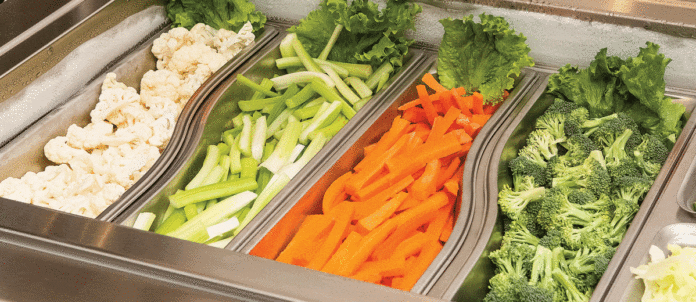Volume 47, Number 9
By: Denise Deveau
[dropcap size=small]R[/dropcap]estaurant buffets are taking on a fresh new look. Today’s foodservice operators are moving away from tried-and-true steam tables and chafing dishes of the past, to create sleeker, modular, multi-functional displays, which keep food fresh and visually appealing.
Conserving space without sacrificing functionality is also important, says Paul McCluskey, principal with Design.net in Acton, Ont. and a noted specialist in kitchen and bar specification and design. “The main trend is having more fire power in less space.”
As a result, induction burners are winning attention within the buffet segment, too. “The quality is there for induction [use] to become widespread,” says McCluskey. “The only issue is induction requires contact with metal [for] heat transfer; so the [drop-in] pan must be the right depth.”
Induction warmers under stone are becoming especially popular, since they can be used with attractive chafing dishes, serving pans or designer crockery for a more attractive presentation. “The induction energy goes through the stone. When it’s turned off, you remove the chafing dish, and all you have is a stone surface. It’s a very attractive way to get away from the typical cafeteria or clinical arrangement; and chefs love the flexibility,” McCluskey says.
The same concept applies to cold surfaces where a metal plate can be placed under a frost stone to maintain the temperature required. Rotisol, from Inglewood, Calif., has cold drop-in displays with a built-in granite slab. Randell, from Conyers, Ga.-based Unified Brands, also has a cold-mount underside with a reservoir for collecting and draining moisture, McCluskey says. And, the more attractive the equipment, the more attention needs to be paid to the serving dishes, he adds. “It’s no good putting in a nice system if you have old pans.”
Robert Bartley, executive chef for Canucks Sports & Entertainment in Vancouver, has chosen to use flat surfaces at the company’s new Loge, a self-serve restaurant, which opened in October. “We tried to revamp the presentation to a home kitchen feeling and get away from chafing dishes,” he explains. The undermount Incogneeto induction systems from Chicago-based CookTek ($2,550 each, plus $205 for the locator disk) feature a Cambria stone surface for placing crockery pots and other vessels. “With this, we get to use very high-end (Lafayette, N.J.-based) Bon Chef crockery,” says Bartley. “It could be a white and chrome double-handed pot or a Dutch oven.” The main difference with this approach is portions are smaller, so food needs to be changed often. “But the quicker rotation means a fresher appearance,” notes Bartley.
Kyle Nordman, principal and co-founder of Savoury Chef Foods, a full-service catering service in Vancouver, says clients increasingly want to create a family style meal presentation. “Everything is refreshed constantly, so food isn’t left out too long,” he explains. While he prefers plating from a kitchen, for buffet meals, he uses single-temperature electric heating pads, which make it easy to restock porcelain dishes and cold-surface equipment for ice-bar or seafood presentations. “We’ve also purchased an induction unit with a stone top from CookTek as well as Eurodib (from Boucherville, Que.) induction single-burner cooktops for chef stations.”
“So many places are pushing the envelope. One induction-buffet station I saw in India had a cover that converted it to a 20-foot table. It was an incredible use of space,” recalls John Higgins, director of George Brown College’s Chef School in Toronto. Back at home, he likes the adaptability of the customized refrigerated offerings from O’Fallon, Mo.-based True and Mississauga, Ont.-based Garland. Induction is also a draw for Higgins. “It’s so much safer than using methyl hydrates [as fuel]. We’re also trying to get away from steam tables, which only stay good for about 15 minutes.”
Versatile food-holding equipment is especially important at the Smokehouse Café in Yellowknife. Its catering service offers local fish and game for various events, which are sometimes held outside in -30°C weather on the middle of a frozen lake. That’s why Roger DeLeeuw, the chef manager, uses two HotCube units from Mentor, Ohio-based Cres Cor. The portable systems have a solar panel for the electrical control and a propane tank for heating. “They can be plugged into the vane when we’re transporting them,” DeLeeuw explains. The units cost $1,200 each, plus an extra $300 for the solar panel, and they hold 12 full pans each. “They’re a lot more durable and can handle a lot of movement. We used to carry Cambro food boxes (from Huntington Beach, Calif.), which was a lot of extra work,” says the Yellowknife chef.
Lisa Aronson, executive chef at The Algonquin Resort in St. Andrews, N.B., doesn’t transport food over ice surfaces, so she relies on seven new Energy Star-rated holding systems from Menomonee Falls, Wis.-based Alto-Shaam to keep food warm at banquets. “At any given time we can be serving multiple groups of 200 to 300 people. Some of the units are kept in a separate holding kitchen across the street. But it’s a great system for re-therming plates, because they can take roll-in racks straight from the ovens.” The chef can place 78 plates on the rack. “They’re a staple for our operation,” she says. “Now that they’re more electronic, you can get much more precise temperature settings. Back in the day, the heat used to come from a bottom element; now it’s more even, and the bottom doesn’t get screaming hot to the point where you can burn yourself.”
Ultimately, many issues factor into buffet and holding equipment purchasing decisions, but must revolve around budgets and flexibility, “otherwise you’ve wasted a lot of money,” notes George Brown’s Higgins.


















